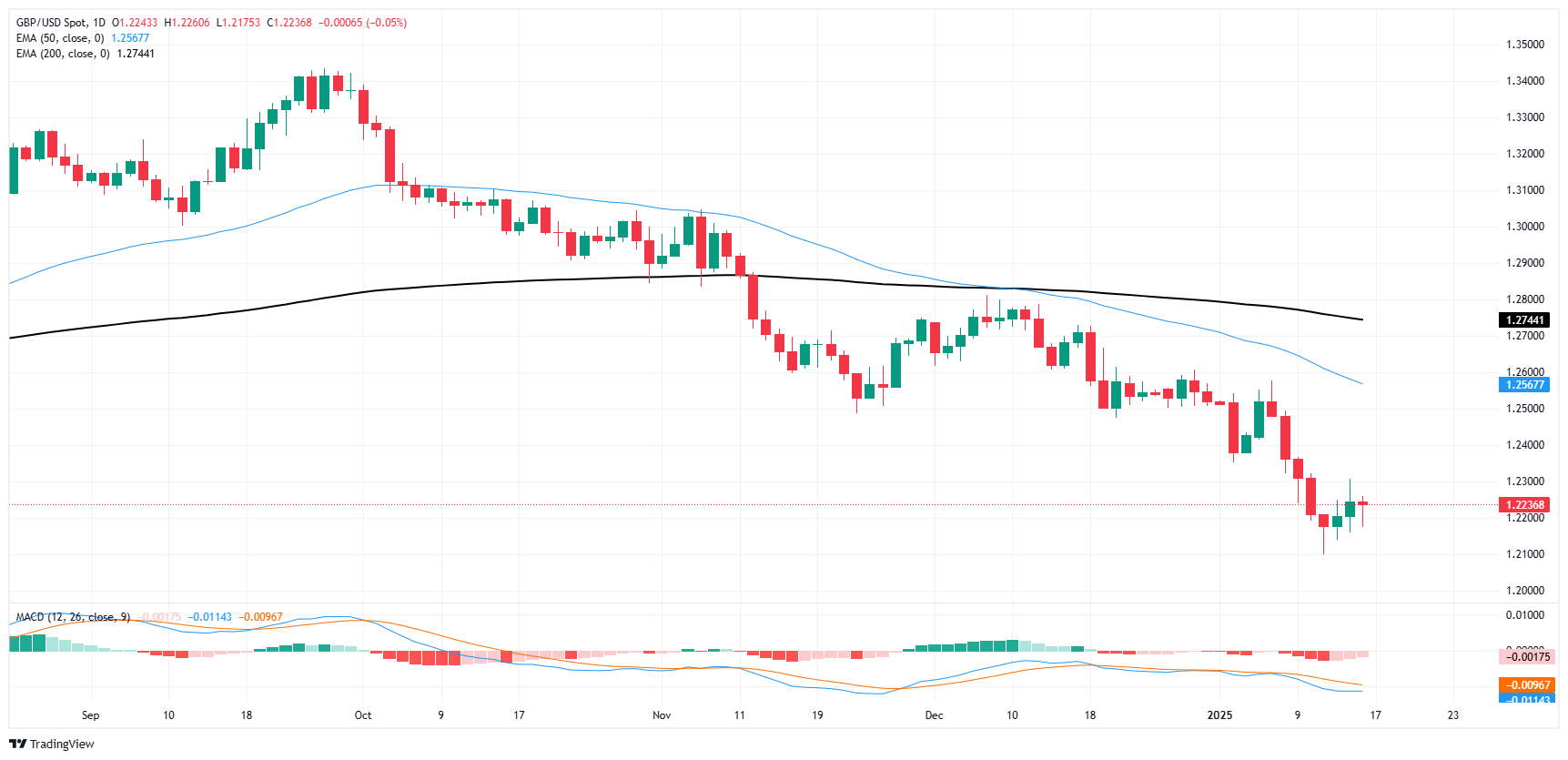- GBP/USD turned around 1.2200 on Thursday as Pound bids falter.
- UK data continues to fail, UK retail sales figures are as follows.
- Currency markets have a rare break from US-focused economic data.
GBP/USD moved into familiar levels on Thursday, posting a flat day after exploring some intraday declines and snapping a two-day winning streak as price action gets stuck in the 1.2200 zone
UK Gross Domestic Product (GDP) growth recovered in November but fell short of median market forecasts, recording a meager 0.1% month-on-month, below the 0.2% expected, and rising only moderately from the previous contraction of -0.1 %. UK industrial production barely budged in November, contracting by 0.4% and completely missing the forecast rebound to 0.1% compared to the previous month’s -0.6% decline.
On the US side, retail sales figures moderated in December, retreating to 0.4% mom in the headline figure. Markets expected a drop to 0.6% from the previous month’s revised 0.8%. Core retail sales, excluding automotive spending, rose to 0.4% month-over-month from 0.2%, meeting analysts’ median forecasts. The mixed numbers failed to cause significant changes in investor sentiment in either direction.
UK retail sales figures for December will be released early during the London market session on Friday and are expected to recover to 0.4% from November’s 0.2% figure. On an annual basis, retail sales are forecast to rise to 4.2% from 0.5% previously, a high median target for an economic zone that has routinely failed to meet market expectations in recent months.
GBP/USD Price Forecast
GBP/USD is struggling to make a significant technical recovery after falling to a new 15-month low late last week. Pound bids bounced around the 1.2100 area, and the price action is getting stuck at the 1.2200 technical level.
Despite some ups and downs on the weekly candles, the Pound is heading for a fourth consecutive monthly close in the red, and the trend certainly looks particularly unfavorable for Pound bulls. However, technical oscillators are deep in bearish territory, and price action traders could be looking to catch a falling knife as broader market momentum pivots.
GBP/USD Daily Chart
British Pound FAQs
The British Pound (GBP) is the oldest currency in the world (AD 886) and the official currency of the United Kingdom. It is the fourth most traded foreign exchange (FX) unit in the world, accounting for 12% of all transactions, averaging $630 billion a day, according to 2022 data. Its key trading pairs are GBP/ USD, which represents 11% of FX, GBP/JPY (3%) and EUR/GBP (2%). The British Pound is issued by the Bank of England (BoE).
The most important factor influencing the value of the Pound Sterling is the monetary policy decided by the Bank of England. The Bank of England bases its decisions on whether it has achieved its main objective of “price stability” – a constant inflation rate of around 2%. Its main tool to achieve this is the adjustment of interest rates. When inflation is too high, the Bank of England will try to control it by raising interest rates, making it more expensive for people and businesses to access credit. This is generally positive for sterling, as higher interest rates make the UK a more attractive place for global investors to invest their money. When inflation falls too much it is a sign that economic growth is slowing. In this scenario, the Bank of England will consider lowering interest rates to make credit cheaper, so that companies will take on more debt to invest in projects that generate growth.
The data released measures the health of the economy and may affect the value of the pound. Indicators such as GDP, manufacturing and services PMIs and employment can influence the direction of the Pound.
Another important data that is published and affects the British Pound is the trade balance. This indicator measures the difference between what a country earns from its exports and what it spends on imports during a given period. If a country produces highly in-demand export products, its currency will benefit exclusively from the additional demand created by foreign buyers seeking to purchase those goods. Therefore, a positive net trade balance strengthens a currency and vice versa in the case of a negative balance.
Source: Fx Street
I am Joshua Winder, a senior-level journalist and editor at World Stock Market. I specialize in covering news related to the stock market and economic trends. With more than 8 years of experience in this field, I have become an expert in financial reporting.







